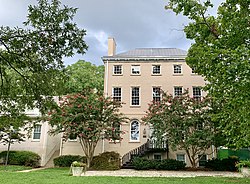
Robert Morris Jr. was an English-born merchant and a Founding Father of the United States. He served as a member of the Pennsylvania legislature, the Second Continental Congress, and the United States Senate, and he was a signer of the Declaration of Independence, the Articles of Confederation, and the United States Constitution. From 1781 to 1784, he served as the Superintendent of Finance of the United States, becoming known as the "Financier of the Revolution." Along with Alexander Hamilton and Albert Gallatin, he is widely regarded as one of the founders of the financial system of the United States.

Gilbert Charles Stuart was an American painter from Rhode Island Colony who is widely considered one of America's foremost portraitists. His best-known work is an unfinished portrait of George Washington, begun in 1796, which is sometimes referred to as the Athenaeum Portrait. Stuart retained the portrait and used it to paint scores of copies that were commissioned by patrons in America and abroad. The image of George Washington featured in the painting has appeared on the United States one-dollar bill for more than a century and on various postage stamps of the 19th century and early 20th century.

Uriah Forrest was an American statesman and military leader from Maryland. Forrest was born in St. Mary's County in the Province of Maryland, near Leonardtown. In his early childhood, he received only limited schooling. Born into a family with three other brothers, he was the direct descendant of a person who came to Jamestown, Virginia, in 1608.

St Mary's College in New Oscott, Birmingham, often called Oscott College, is the Roman Catholic seminary of the Archdiocese of Birmingham in England and one of the three seminaries of the Catholic Church in England and Wales.
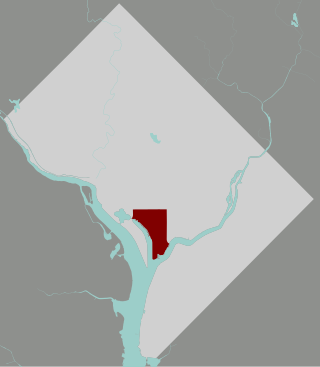
The Southwest Waterfront is a neighborhood in Southwest Washington, D.C. The Southwest quadrant is the smallest of Washington's four quadrants, and the Southwest Waterfront is one of only two residential neighborhoods in the quadrant; the other is Bellevue, which, being east of the Anacostia River, is frequently, if mistakenly, regarded as being in Southeast

Arthur Livermore was an American politician and attorney who served as a United States representative from New Hampshire.
The Panic of 1796–1797 was a series of downturns in credit markets in both Great Britain and the newly established United States in 1796 that led to broader commercial downturns. In the United States, problems first emerged when a land speculation bubble burst in 1796. The crisis deepened when the Bank of England suspended specie payments on February 25, 1797 under the Bank Restriction Act of 1797. The Bank's directors feared insolvency when English account holders, who were nervous about a possible French invasion, began withdrawing their deposits in sterling rather than bank notes. In combination with the unfolding collapse of the U.S. real estate market's speculative bubble, the Bank of England's action had deflationary repercussions in the financial and commercial markets of the coastal United States and the Caribbean at the start of the 19th century.

Newton D. Baker House, also known as Jacqueline Kennedy House, is a historic house at 3017 N Street NW in Washington, D.C. Built in 1794, it was home of Newton D. Baker, who was Secretary of War, during 1916–1920, while "he presided over America's mass mobilization of men and material in World War I. After the assassination of president John F. Kennedy in 1963, Jacqueline Kennedy purchased the house and lived here for about a year.
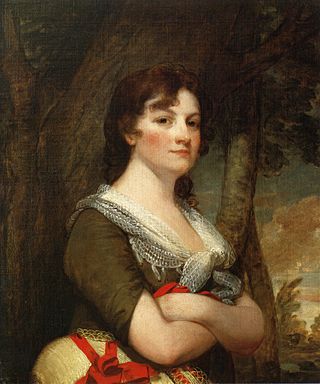
Elizabeth (Eliza) Parke Custis Law was the eldest granddaughter of Martha Dandridge Washington and a step-grandchild of George Washington. She married Thomas Law, the youngest son of the late bishop of Carlisle, England, and an experienced administrator with the East India Company.
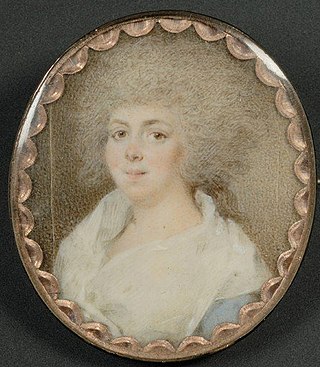
Eleanor Calvert Custis Stuart, born Eleanor Calvert, was a prominent member of the wealthy Calvert family of Maryland. Upon her marriage to John Parke Custis, she became the daughter-in-law of Martha Dandridge Custis Washington and the step-daughter-in-law of George Washington. Her portrait hangs today at Mount Airy Mansion in Rosaryville State Park, Maryland.
John Law (1745–1810) was an English mathematician and clergyman who began his career as a Fellow of Christ's College, Cambridge, and went on to become chaplain to the Lord Lieutenant of Ireland and Church of Ireland bishop of Clonfert and Kilmacduagh (1782–1787), Killala and Achonry (1787–1795), and finally of Elphin (1795–1810).
Hope Park was an 18th and 19th-century plantation in Fairfax County in the U.S. state of Virginia, where Dr. David Stuart (1753–1814), an old friend of and correspondent with George Washington lived with his wife, Eleanor Calvert Custis (1758–1811), and family. It was approximately 5 miles (8.0 km) southwest of Fairfax Court House.

P Street refers to four different streets within the city of Washington, D.C. The streets were named by President George Washington in 1791 as part of a general street naming program, in which east–west running streets were named alphabetically and north–south running streets numerically.
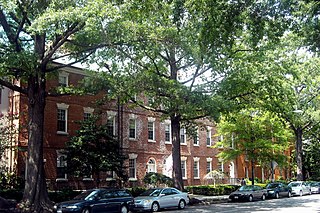
Wheat Row is a row of four Late Georgian style townhouses located at 1315, 1317, 1319, and 1321 4th Street SW in the Southwest Waterfront neighborhood of Washington, D.C., in the United States. Begun in 1794 and completed in 1795, the structures are some of the oldest residential homes in the District of Columbia. They served several uses in the early and mid 20th century, but were integrated into the Harbour Square apartment cooperative in 1963. Wheat Row was added to the National Register of Historic Places on July 23, 1973.

Thomas Law, was a reformer of British policy in India, where he served as collector of revenue for the East India Company. Working with Lord Cornwallis, governor-general of India, Law formulated a major policy known as the Permanent Settlement, which served as the basis for land tenure and taxation policy for natives during subsequent decades of British rule. He returned to England for his health in 1791, taking with him his three illegitimate sons borne of his Indian mistress.

The Seven Buildings were seven townhouses constructed on the northwest corner of Pennsylvania Avenue NW and 19th Street NW in Washington, D.C., in 1796. They were some of the earliest residential structures built in the city. One of the Seven Buildings was the presidential home of President James Madison and his wife, Dolley, after the burning of the White House in 1814, and later the residence of Martin Van Buren shortly before and after his inauguration as president. Most of the buildings were demolished in 1959. The facades of two buildings were incorporated into the Embassy of Mexico in 1986.
Knox v. Greenleaf, 4 U.S. 360, is a ruling by the United States Circuit Court for the District of Pennsylvania which held that, under the Pennsylvania Constitution of 1790, citizenship of the state is conferred upon moving to the state and paying taxes.

James Greenleaf was a late 18th and early 19th century American land speculator responsible for the development of Washington, D.C., after the city was designated as the nation's capital following passage of the Residence Act in 1790. A member of a prominent and wealthy Boston family, he married a Dutch noblewoman, who he later abandoned and then divorced, and served briefly as consul at the United States embassy in Amsterdam.
O'Neale v. Thornton, 10 U.S. 53 (1810), is a ruling by the Supreme Court of the United States which held that neither the state of Maryland nor the government of the District of Columbia authorized the resale of foreclosed government land at a price less than the original sale price. In establishing the District of Columbia, the D.C. government had sold land to original investors at $66.50 per lot. The investors failed to pay, so the government foreclosed and resold the land to a second investor at the same price. The second investor failed to pay, so the government foreclosed again and sold the land to a third investor at a price lower than the original sale price. This third sale, the Supreme Court said, was illegal. Title should be returned to the second buyer, although the government was still free to seek foreclosure against that buyer on the basis of nonpayment.
